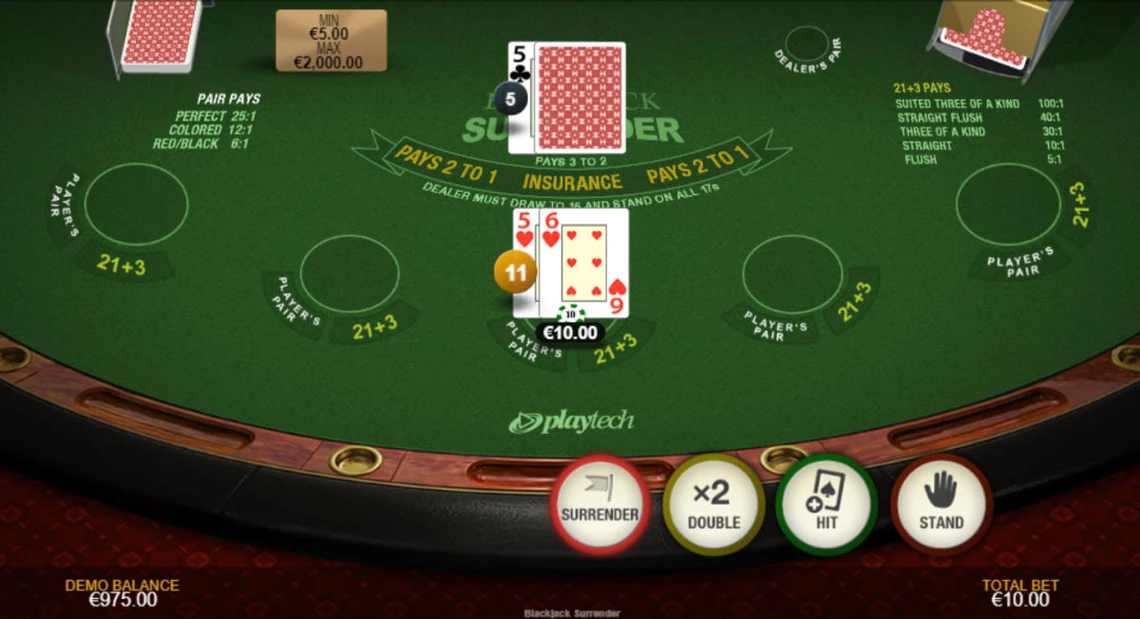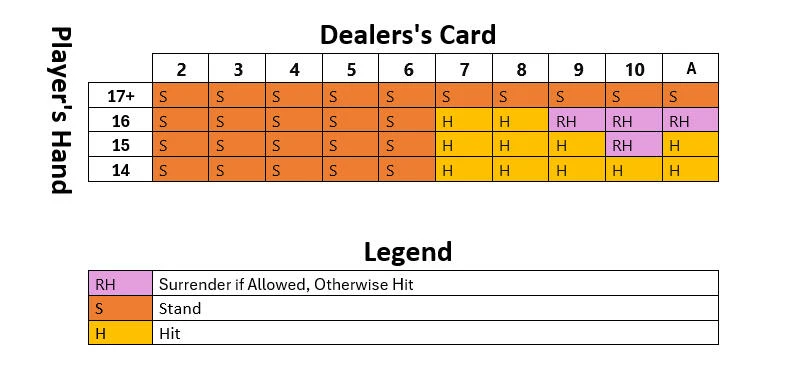
When to Surrender in Blackjack?

Blackjack, a staple in casinos worldwide, combines elements of luck and strategy, offering players numerous ways to improve their odds. One often underutilized strategy is surrendering, a move that can save players from significant losses in unfavourable situations. This article delves into the concept of surrender in blackjack, exploring its rules, types, and strategic applications. We will examine how surrender works in both real and online casinos, discuss optimal surrender scenarios, and provide practical examples. Additionally, we'll address the advantages and disadvantages of using this strategy.
What Does Surrender Mean in Blackjack?
In blackjack, surrender is a strategic option that allows a player to forfeit half of their original bet and fold their hand, effectively ending their participation in that round. This can be a valuable tactic when the player's hand has a very low probability of winning against the dealer's upcard. By choosing to surrender, players can minimize their losses rather than risk their entire bet on a hand that is likely to lose.
The Two Types of Surrender
There are two main types of surrender in blackjack: early surrender and late surrender. Each type has distinct rules and availability, which can significantly impact a player's strategy.
Early Surrender
Early surrender allows players to surrender their hand before the dealer checks for blackjack. This option is particularly advantageous because it allows the player to cut their losses even before knowing if the dealer has a blackjack. Unfortunately, early surrender is less commonly available in modern casinos, as it reduces the house edge more significantly compared to late surrender.
- Example Scenario: If a player holds a hand totalling 16 and the dealer's upcard is an Ace, opting for early surrender allows the player to forfeit half their bet before the dealer checks for blackjack, thus avoiding a likely loss.
Late Surrender
Late surrender, on the other hand, allows players to surrender only after the dealer has checked for blackjack. If the dealer has blackjack, the option to surrender is no longer available, and the player loses their entire bet. If the dealer does not have blackjack, the player can then choose to surrender and reclaim half of their bet.
- Example Scenario: If a player holds a hand totalling 16 the dealer's upcard is a 10, and the dealer does not have blackjack, the player can opt for late surrender, thereby losing only half their bet instead of potentially losing the entire amount if they continued to play.
How Does Blackjack Surrender Work?
Basic Rules
Surrendering in blackjack allows a player to forfeit half of their bet and end their participation in the round. This strategic move can only be used under specific conditions and at certain points in the game. Here are the basic rules:
- Timing: Surrender can only be declared immediately after the initial deal and before any other actions (such as hitting or standing) are taken.
- Forfeiting Bet: The player forfeits half of their original bet and retains the other half.
- Dealer Conditions: In the case of late surrender, the dealer must first check for blackjack. If the dealer has blackjack, the surrender option is voided, and the player loses the entire bet.
Difference between land-based casinos and online casinos
On Real Casinos
In brick-and-mortar casinos, surrendering works as follows:
- Indicating Surrender: Players usually indicate their intention to surrender by verbally stating "surrender" or using a hand signal specific to that casino.
- Dealer Confirmation: The dealer acknowledges the surrender, removes half of the player's bet from the table, and the round ends for that player.
- House Rules: Availability and rules regarding surrender can vary significantly between casinos. Some casinos may not offer the surrender option at all.
On Online Casinos
In online blackjack games, surrendering is typically straightforward:
- User Interface: Online platforms will have a clear button or option labelled "Surrender" which the player can click after the initial deal.
- Automated Process: The system automatically calculates and forfeits half of the player's bet, and the round ends for the player.
- Game Variations: Online casinos may offer more consistent surrender options across different blackjack variations compared to physical casinos.
Advanced considerations
Always Available or Only on Certain Tables?
Surrender is not always available on all blackjack tables. Its availability depends on the house rules of the casino or the specific blackjack variant being played. Players should check the rules of the table or online game before starting to play to know if surrender is an option.
Works Differently Depending on the Version of the Blackjack?
Yes, the surrender option can work differently depending on the version of blackjack being played. Key differences include:
- Early vs. Late Surrender: As discussed, early surrender (available before the dealer checks for blackjack) is less common and more advantageous than late surrender.
- Single-Deck vs. Multi-Deck: Some casinos may offer surrender only in multi-deck games or may have different rules for single-deck games.
- Regional Variations: European blackjack and American blackjack might have different surrender rules. For example, some European blackjack variants do not offer surrender at all.
When to Surrender in Blackjack?
Knowing when to surrender in blackjack can significantly improve a player's strategy by minimizing losses in unfavourable situations. The decision to surrender hinges on whether you are playing a game that allows for late surrender or, less commonly, early surrender.
Late Surrender
The more commonly available options are both online and brick-and-mortar casinos. It allows players to surrender their hand and reclaim half of their bet only after the dealer checks for blackjack.
Optimal Strategies for Late Surrender:
- Player's Hand: 16 vs. Dealer's Upcard: 9, 10, or Ace: A hand totalling 16 is particularly vulnerable when the dealer shows a high card. The probability of the player winning is low and surrendering minimizes losses.
- Player's Hand: 15 vs. Dealer's Upcard: 10: Similarly, a hand totalling 15 against a dealer’s 10 is likely to lose. Surrendering here helps in cutting potential losses.
Statistical Justification:
- In these scenarios, the player's chances of busting or losing are higher than usual. By surrendering, the player saves half of their bet, which is statistically better than losing the full amount over the long term.
Early Surrender
Allows players to surrender their hand before the dealer checks for blackjack. This option is less common but provides a greater advantage when available, as it gives players more opportunities to surrender in unfavourable conditions.
Optimal Strategies for Early Surrender:
- Player's Hand: 16 vs. Dealer's Upcard: 10 or Ace: Surrendering before the dealer checks for blackjack can save a significant portion of the bet in these high-risk situations.
- Player's Hand: 14-16 vs. Dealer's Upcard: 10: These hands are weak against a dealer’s strong upcard. Early surrender offers a strategic way to cut losses before the dealer’s potential blackjack is confirmed.
- Player's Hand: 12-17 vs. Dealer's Ace: When the dealer shows an Ace, the probability of the dealer having a strong hand is high. Early surrender can be a strategic move to avoid greater losses.
Statistical Justification:
- Early surrender reduces the house edge more significantly than late surrender. In the right circumstances, early surrender can lower the house advantage by a considerable margin, making it a highly beneficial strategy when available.
Blackjack Split Chart: When to Surrender?
To effectively utilize the surrender strategy in blackjack, it's essential to know the specific situations where surrendering offers the greatest advantage. A surrender chart provides a quick reference to these optimal scenarios, helping players make informed decisions at the table.

What Are the Limits of Blackjack Surrender?
While surrendering in blackjack can be a valuable strategy to minimize losses, it is not without its limitations. Understanding these constraints can help players use the surrender option more effectively and avoid common pitfalls.
Limited Availability
- Not Universally Available: One of the primary limitations is that surrender is not offered at all blackjack tables. Many casinos, especially brick-and-mortar ones, do not include the surrender option in their standard rules.
- Game Variants: Even in casinos that do offer surrender, it may only be available in specific variants of blackjack. For example, it might be available in multi-deck games but not in single-deck games, or American blackjack but not in European blackjack.
Timing Constraints
- Late Surrender: In games that allow late surrender, players can only surrender after the dealer checks for blackjack. If the dealer has a blackjack, the surrender option is voided, and the player loses their entire bet.
- Early Surrender: Early surrender, though more advantageous, is rarely offered. Its limited availability means players cannot always rely on this option when facing unfavourable hands.
Strategic Complexity
- Decision-Making: Deciding when to surrender requires a solid understanding of blackjack strategy and the specific probabilities involved. Players must be able to quickly assess their hand and the dealer's upcard to make the best decision.
- Discipline: Surrendering can feel counterintuitive, as it involves forfeiting part of the bet without seeing the outcome of the hand. Players need to remain disciplined and stick to the strategy, even when it feels like giving up.
House Rules
- Variations in Rules: House rules can vary significantly from one casino to another. Some casinos may have specific restrictions on surrendering, such as not allowing it on certain hands or requiring additional conditions to be met.
- Dealer Actions: In some versions of blackjack, the dealer's actions (such as hitting on soft 17) can influence the effectiveness of the surrender strategy. Players need to be aware of these nuances to optimize their play.
Financial Impact
- Half Bet Loss: Although surrendering minimizes losses, players still lose half of their original bet. Overuse of the surrender option can erode a player’s bankroll, especially if they misidentify situations where surrendering is not optimal.
Advantages and Disadvantages of Surrender
Understanding the pros and cons of surrendering in blackjack can help players make more informed decisions and better integrate this strategy into their overall gameplay. Below is a table outlining the key advantages and disadvantages of using the surrender option in blackjack.
Minimizes Losses: Surrendering allows players to save half of their bet in unfavourable situations, reducing overall losses.
Reduces House Edge: Proper use of the surrender strategy can reduce the casino's advantage, especially in games that allow early surrender.
Strategic Flexibility: Surrender adds a strategic layer to the game, giving players more options to manage their bets.
Beneficial in High-Risk Hands: Surrendering is particularly useful in high-risk hands where the chances of winning are very low.
Reduced Risk of Busting: By surrendering, players avoid the risk of busting and losing their entire bet on weak hands.
Not Universally Available: The surrender option is not available at all blackjack tables or in all game variants.
Requires Discipline: Players must remain disciplined and not overuse surrender, even when it feels counterintuitive.
Complex Decision-Making: Deciding when to surrender requires a good understanding of probabilities and quick decision-making skills.
Timing Constraints: Late surrender is only available after the dealer checks for blackjack, limiting its use.
Financial Impact: Even though it minimizes losses, surrendering still means losing half of the original bet, which can add up over time.
Our opinion about Blackjack Surrender
Surrendering in blackjack is a valuable strategy that can significantly minimize losses in high-risk situations. By understanding when to use early and late surrender, players can improve their overall gameplay and reduce the house edge.
In my opinion, mastering the surrender option is essential for serious blackjack players. Although it may feel counterintuitive to forfeit a hand, the statistical benefits make it a smart choice in specific scenarios. Incorporating surrender into your strategy can lead to more confident and effective play. However, surrender is not always available and should be used judiciously. Over-reliance without understanding can result in unnecessary losses.
In conclusion, when used correctly, surrendering can enhance your blackjack strategy and lead to better outcomes at the table.

Author
Content Writer
